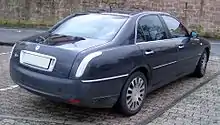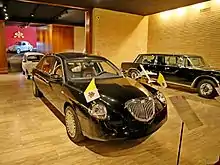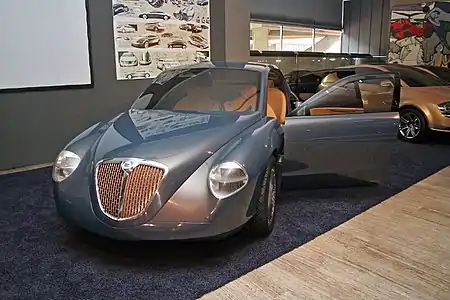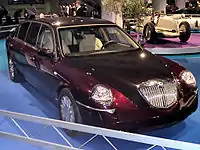Lancia Thesis
The Lancia Thesis (Type 841) is an executive car produced by Italian automaker Lancia between 2001 and 2009. It was available with naturally aspirated and turbocharged engines ranging between 2.0 and 3.2 litres, in both straight-5 or V6 configurations. Its appearance was based on the 1998 Diàlogos concept car. The production car premiered at the Geneva Motor Show in March 2001 and its interior was displayed for first time at the Frankfurt Motor Show. Sales started in June 2002 in Italy, with export markets following shortly after.[4]
| Lancia Thesis | |
|---|---|
 | |
| Overview | |
| Manufacturer | Lancia |
| Production | 2001–2009[1] |
| Assembly | Rivalta plant, Turin, Italy (2001–2002) Mirafiori plant, Turin, Italy |
| Designer | Michael Robinson at Centro Stile Lancia[2] Flavio Manzoni[3] (interiors) |
| Body and chassis | |
| Class | Executive car (E) |
| Body style | 4-door saloon |
| Layout | FF layout |
| Powertrain | |
| Engine | Petrol: 2.0 L I5 Turbo 20V 2.4 L I5 20V 3.0 L Alfa Romeo V6 24V 3.2 L Alfa Romeo V6 24V Diesel: 2.4 L I5 JTD 20V |
| Transmission | 5-speed automatic 6-speed manual |
| Dimensions | |
| Wheelbase | 2,800 mm (110.2 in) |
| Length | 4,890 mm (192.5 in) |
| Width | 1,830 mm (72.0 in) |
| Height | 1,470 mm (57.9 in) |
| Curb weight | 1680-1895 kg (3703-4177 lb) |
| Chronology | |
| Predecessor | Lancia Kappa |
| Successor | Lancia Thema (LX-based version) |



History

Earliest prototype of Thesis was 2000 Giubileo, presented to Pope John Paul II, bearing very similar body although modified as a landaulet.
Concerning the design, Lancia's chief designer said "People will be looking for excuses not to buy this car. So, we wanted to be damn sure we didn't give them anything to hook onto.[5]" To that end the car was intended to match the substance of the Audi A6 and Mercedes E-class. It was fitted with more technology and "more style".[5] To convince buyers it was also priced to be 15% cheaper than the competition. In the view of motoring writer Paul Horrell of the UK's CAR Magazine the shape was "controversial, but certainly regenerates an authentic Italian alternative to the po-faced approach" of the competition. "Look at that extravagant front end, like a row of chrome-decorated sand dunes. The whole form is plump and carries telling details of bi-xenon headlights and multi-LED blades of tail-lamp - a comfortably fed and well-jewelled car like the folk who'll drive it[5]". Discussing the interior, Horrell went on to say: "The effect is redoubled within. The cabin is truly rich, and walks the right side of that line in Italian style dividing the perfectly proportioned minimalism from their bling-bling rap-star Versace vulgarity.[5]" A notable feature of the interior was the use of high quality, lightly varnished wood trim and cast magnesium for the centre console. "I can't tell you," wrote Horrell[5] "how much more satisfying it is to use a cupholder or ashtray that glides out of solid metal than some clacky plastic lid." After describing the engraved glassware of the instruments which were notable for their needles "floating at depth" CAR concluded that "it felt expensive[5]".
Lancia invested heavily in the Thesis and, unlike the predecessor the Kappa which shared an automobile platform with the Alfa Romeo 166, the Thesis was designed with its own chassis.[5] The car was fitted with a "complicated multi-arm aluminium-intensive suspension at both ends, augmented by Mannesmann Sachs 'Skyhook' adaptive dampers" which were also used on the Maserati Spyder.[5] It was also the first Lancia with radar adaptive cruise control (by Bosch).[6]
Describing the driving quality, Horrell wrote: "You can tell it's a heavy car, but there's no distress in letting this [test car with the V6 engine] build up a gentle sweat. Its autobox is attentive and smooth. The engine, though quieter than in any Alfa, is all you hear because road and wind noise have been quashed. Ditto rattles. This is a tight ship.[5] The Thesis' ride is just terrific. It swallows big lumps, whatever your speed. Yet there's no heaving in distress; the adjustable dampers keep body motion in check. They're even better when the stress is lateral; considering the pillowy straight-line character, cornering roll is amazingly well-controlled.[5]" The main criticism was the steering which was considered by Horrell to be too light, and the slight tendency to understeer leading to intrusion of the ESP system. In conclusion, CAR's Horrell summed up the Thesis as being "far more accurate and even agile than it has any right to be.[5]" CAR's view was that the Thesis was a dignified expression of Lancia's brand values, then. "Imagine a Rover 95 and you would be spookily close. It's a scary thought: two brands that refuse to be youthful or sporty, two brands that have underperformed.[5]" Other suggestions were that the car was a good product in the wrong market place. In this view, it would have been better to offer a vehicle in the Mondeo price range rather than the more conservative sector contested by the Mercedes E-Class and BMW 5 Series.[7]
The Thesis is equipped with 6-speed manual or 5-speed automatic "Comfortronic" (not for 2.0) gearboxes. The interior was trimmed with leather or the suede-like Alcantara material long favoured by Lancia. CAR's verdict was that "If Lancia can be turned around this is the car for the job.[5]" Despite its very comprehensive equipment level and the improved fit and finish, sales remained well behind its predecessor, the Kappa, quite far behind the competition and finally the model was discontinued at the beginning of 2009, after only 16,000 units built.[8] Thesis was replaced starting from 2011 by a new flagship sedan, based on the next-generation Chrysler 300, re-branded in continental Europe as the Lancia Thema.[1][9]
Versions
| Model | Power | Torque | Displacement | Engine | Top speed | 0–100 km/h (0-62 mph)(s) | Years |
|---|---|---|---|---|---|---|---|
| 2.0 Turbo 20V manual | 185 PS (136 kW; 182 hp) @ 5500 rpm | 308 N⋅m (227 lb⋅ft) @2200 rpm | 1998 cc | straight-5 | 224 km/h (139 mph) | 8,9 | until 2007 |
| 2.4 20V manual | 170 PS (125 kW; 168 hp) @ 6000 rpm | 226 N⋅m (167 lb⋅ft) @3500 rpm | 2446 cc | straight-5 | 217 km/h (135 mph) | 9,5 | until 2007 |
| 2.4 20V automatic | 170 PS (125 kW; 168 hp) @ 6000 rpm | 226 N⋅m (167 lb⋅ft) @3500 rpm | 2446 cc | straight-5 | 215 km/h (134 mph) | 10,9 | until 2007 |
| 3.0 V6 24V automatic | 215 PS (158 kW; 212 hp) @ 6300 rpm | 263 N⋅m (194 lb⋅ft) @5000 rpm | 2959 cc | V6 | 234 km/h (145 mph) | 9,2 | until 2004 |
| 3.2 V6 24V automatic | 230 PS (169 kW; 227 hp) @ 6200 rpm | 289 N⋅m (213 lb⋅ft) @4800 rpm | 3179 cc | V6 | 240 km/h (150 mph) | 8,8 | until 2004 |
| 2.4 10V JTD | 150 PS (110 kW; 148 hp) @ 4000 rpm | 305 N⋅m (225 lb⋅ft) @1800 rpm | 2387 cc | straight-5 | 206 km/h (128 mph) | 10,1 | until 2005 |
| 2.4 Multijet automatic | 175 PS (129 kW; 173 hp) @ 4000 rpm | 330 N⋅m (243 lbf⋅ft) @2000 rpm | 2387 cc | straight-5 | 220 km/h (140 mph) | 9,8 | 2003-2006 |
| 2.4 Multijet manual | 175 PS (129 kW; 173 hp) @ 4000 rpm | 380 N⋅m (280 lbf⋅ft) @2000 rpm | 2387 cc | straight-5 | 225 km/h (140 mph) | 10,2 | 2003-2006 |
| 2.4 Multijet automatic | 185 PS (136 kW; 182 hp) @ 4000 rpm | 330 N⋅m (243 lbf⋅ft) @1750 rpm | 2387 cc | straight-5 | 222 km/h (138 mph) | 9,7 | from 2006 |
| Thesis fuel consumption | ||||||||||||||
|---|---|---|---|---|---|---|---|---|---|---|---|---|---|---|
| l/100 km | 2.0 TB | 2.4 | 2.4 Aut. | 3.2 V6 Aut. | 2.4 20v JTD Aut. | |||||||||
| Urban Extra-urban Combined | 15.5 8.5 11.1 | 15.2 8.4 10.9 | 17.4 8.8 12.0 | 22.7 10.3 14.9 | 12.1 6.9 8.8 | |||||||||
| CO2 emissions g/km | 264 | 260 | 286 | 355 | 234 | |||||||||
Lancia Thesis Stola S85

At the 2004 Geneva Motor Show, a 60 centimetres (24 in)[10] stretched limousine version (5.49 m (216 in)) prototype was shown, made by Stola S.p.A. and named as the "Stola S85" to celebrate the Stola company's 85 years.[11] The car is equipped with a beige leather interior and electrically adjustable rear seats. The car has also a minibar with refrigerator, multimedia system with GPS navigation system, internet access, fax machine and a DVD player.[10] With 230 PS (169 kW; 227 hp) and all these extra features the converted car weighs 2,030 kg (4,475 lb) and can accelerate from 0 to 100 km/h (62 mph) in 9.2 seconds, with a top speed of 230 km/h (143 mph).
Notes
- "15.10.2009 CHRYSLER AND LANCIA BRANDS DRAWN TOGETHER BY FIAT". www.italiaspeed.com/2009. Retrieved 13 December 2010.
- "Designer". ajovalo.net. Retrieved 8 February 2012.
- "Lancia Thesis, interweaving ideas". autodesignmagazine.com. Retrieved 8 February 2019.
- "4th June 2002: Fiat Auto head denies restructuring talks with GM". italiaspeed.com/news_2002. Retrieved 6 February 2008.
- CAR magazine, February 2002:30
- "Launch of top-of-the-range Lancia Thesis is delayed further". Europe.autonews.com. 24 September 2001. Retrieved 20 January 2016.
- "2002 Lancia Thesis 3.0 V6 Review". Driven To Write. 12 May 2014. Retrieved 20 January 2016.
- "Lancia to unveil Chrysler-based flagship, new Ypsilon". autonews.com. Retrieved 13 December 2010.
- "Lancia, Chrysler to share products". leftlanenews.com. Retrieved 13 December 2010.
- "Lancia Thesis Stola S85". ultimatecarpage.com. Retrieved 14 December 2007.
- "Lancia Thesis S85". blutecsrl.it. Retrieved 19 July 2019.